|
|
| |
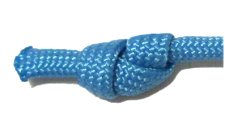
|
| |
| |
|
Description: The Stevedore
Knot is considered a stopper knot
because it prevents the cord from slipping out
of another knot. It's also used to prevent
the end of the cord from unraveling.
This knot is used in Macrame to finish the
ends of cords in the final steps, or for
preparation. It's a good way to
prepare cords that are slippery, such as when
you use Parachute cord or Satin (nylon).
This is a great knot to use when making fringe,
since it has a strong hold and does not untie
easily.
Since it can be tied anywhere on a cord, you
can also use it just for decoration.
|
| |
|
|
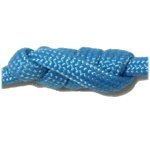
|
|
The Chinese
Step Knot is an expanded
variation of the Stevedore knot.
Click on the image or link to learn how to
tie it. |
|
|
|
|
|
Tying Instructions
|
| |
| |

|
|
Step 1: You need one
piece of material, at least 12 inches
long. Secure it on the right.
Make a clockwise
loop 4
- 6 inches
from the end of the cord. Pass the
working end under
the secured end to complete the loop.
|
|
| |
|
| |

|
|
Step
2: Make another clockwise
loop, passing over
both sides of the first loop.
This loop should be small, and rest close
to the crossing point of the first loop. |
|
| |
|
| |
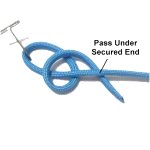
|
|
Step
3: Still moving clockwise,
pass the working end under
the secured end of the cord.
Tighten the small loop slightly, so you
have enough material for the next step.
|
|
| |
|
| |

|
|
Step
4: Bring the working end
through the first loop, passing over
- under as shown. |
|
| |
|
| |
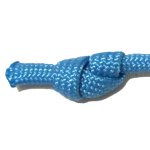
|
|
Step 5: To
tighten, pull both ends gradually,
sliding the two loops toward each other.
You can now finish off the tip of the
cord in the manner most appropriate for
your project.
|
|
| |
|
|
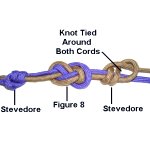
|
|
This knot is
often used to prevent other knots from
untying.
In this image, the knot was tied on both
sides of a Figure 8 knot. |
|
|
|
|
|
|
| By using any
text or images on Free Macrame Patterns, you are
agreeing to our Terms of Use |
|
|
|
|
Have
any comments about the Stevedore Knot? Contact
Me.
|
|
|
| |
 |
| |
|
| |



